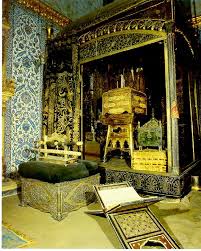Architecture & Sacred Relics at Phra That Chae Haeng | Sacred Buddhist Temple in Thailand
Phra That Chae Haeng, one of the most revered Buddhist temples in Nan Province, Thailand, is not only a site of deep spiritual devotion but also a masterpiece of Northern Thai architecture. Nestled atop a hill in Phu Phiang District, this sacred temple has stood for more than six centuries as a symbol of faith, artistry, and cultural heritage. Beyond its role as a religious sanctuary, Phra That Chae Haeng is an architectural wonder and a repository of sacred relics that continue to inspire both pilgrims and visitors from around the world.
The Architectural Grandeur of Phra That Chae Haeng
The temple is most famous for its magnificent golden chedi (stupa), which rises majestically above the surrounding landscape. Built in 1355 during the reign of Chao Phraya Kan Muang, the chedi reflects a unique fusion of Lanna and Lao architectural styles. Its towering form, covered entirely in gleaming gold, symbolizes the radiance of the Buddha’s teachings and serves as a spiritual beacon visible from afar.
The stupa is said to enshrine a relic of the Buddha’s hair, making it an immensely sacred site for devotees. The architectural details of the chedi include lotus motifs, layered tiers, and intricate carvings, all carefully designed to represent Buddhist cosmology. Each element, from the base to the pinnacle, carries symbolic meaning: the square foundation represents the earth, the rounded dome symbolizes water, the spire signifies fire, and the umbrella at the top reflects the sky and enlightenment.
Sacred Relics and Spiritual Symbolism
At the heart of Phra That Chae Haeng lies its most treasured possession: the relics of the Buddha. For centuries, these relics have drawn pilgrims who come to pay homage, meditate, and seek spiritual merit. The presence of these relics elevates the temple into a powerful sacred site, believed to bring blessings of peace, prosperity, and protection to those who make the journey.
In addition to the Buddha’s hair relic, the temple houses sacred scriptures, ancient Buddha images, and ceremonial objects used in important Buddhist rituals. The relics are enshrined within layers of the golden chedi, protected and honored through annual ceremonies and festivals, particularly during Visakha Bucha Day and the Nan Boat Racing Festival when devotees gather in great numbers.
Temple Complex and Artistic Elements
The Phra That Chae Haeng complex is more than its iconic stupa. It includes beautifully decorated viharns (ordination halls), elaborate gates, and traditional wooden structures that exemplify Lanna artistry. The temple grounds are adorned with statues of mythical creatures such as nagas (serpent deities), which are believed to guard the sacred relics and ward off negative forces.
Murals and carvings inside the temple halls depict stories from the Jataka tales, teaching moral lessons through the life of the Buddha’s previous incarnations. These artistic elements not only enhance the temple’s beauty but also serve as educational tools for devotees and monks, reinforcing Buddhist values and teachings.
Cultural and Historical Significance
Phra That Chae Haeng holds a central place in the cultural identity of Nan Province. For generations, it has been the spiritual heart of the community, where locals celebrate festivals, hold merit-making ceremonies, and pass down traditions. The temple is also associated with astrology and zodiac beliefs: those born in the year of the Rabbit consider this their auspicious temple, and visiting it is said to bring good fortune and protection.
Historically, the temple represents the expansion of Theravāda Buddhism across Northern Thailand and its integration with local traditions. Its architectural style illustrates the cultural exchange between the Lanna Kingdom and neighboring Lao territories, making it an important cultural bridge in the region.
A Living Heritage
Today, Phra That Chae Haeng remains a vibrant center of Buddhist practice. Monks reside within its grounds, conducting daily rituals and guiding visitors in meditation. Pilgrims continue to climb the long staircase leading to the chedi, offering flowers, candles, and prayers at the foot of the sacred stupa. Beyond its religious role, the temple also attracts architects, historians, and travelers who admire its design and craftsmanship.
Visitors who step onto its grounds often remark on the serene atmosphere—an environment where time slows, and the harmony between architecture, sacred relics, and natural surroundings creates a profound sense of peace.
Conclusion
Phra That Chae Haeng is more than a Buddhist temple; it is a timeless monument that embodies the union of faith, artistry, and culture. Its golden stupa, sacred relics, and intricate Lanna architecture stand as testaments to Thailand’s rich spiritual heritage. For those who seek not only to admire beauty but also to experience a deep connection to Buddhist tradition, Phra That Chae Haeng offers a journey of reverence and discovery—an encounter with both the sacred and the sublime.
